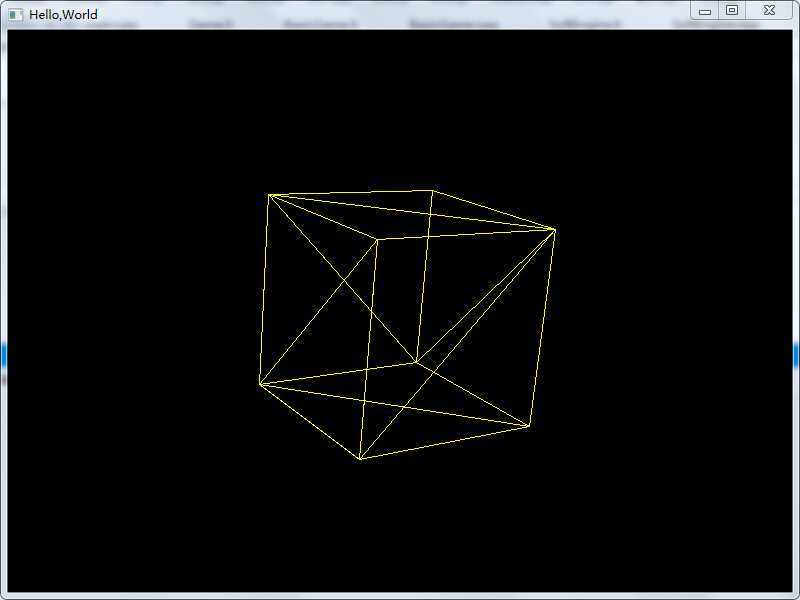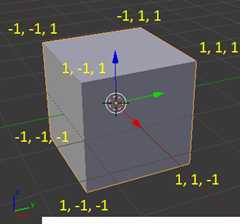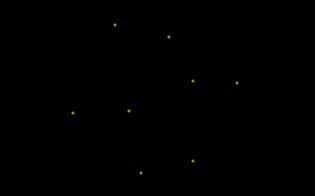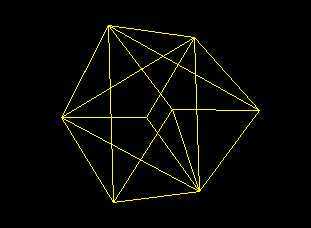使用Windows GDI 做一个3D”软引擎“-Part1
2020-12-13 03:19
标签:des style class blog code java 前: 最近几天一个很虎比的教程吸引了我的视线,原作者使用c# / JavaScript逐步实现了一个基本的3D软引擎。 我不懂上面提到的语言,所以,准备用我熟悉的C++和Win32实现重造这个轮子。:) 注意: 正文: 本文将实现下面这个小玩意(仅仅使用Win32中的SetPixel()函数): 源码下载:链接: http://pan.baidu.com/s/1kTidLYn 密码: 5qul (注:源码中使用了一点C++11的特性,请使用支持C++11的编译器编译) 1.创建窗口. 要绘制东西,首先要有一个窗口,为此我们设计一个BasicGame类: BasicGame.h BasicGame.cpp BasicGame简单的对窗口创建进行了封装,其中 是为了后面实现游戏循环预留的接口,我们要创建窗口,只需要继承BasicGame就可以了。 2.游戏循环。 利用上面的类,我们便可以这样写WinMain()函数: 换成 然后再NewGame类中实现init(),render(),quit(),update(float)四个函数即可。 GetTickCount()函数返回系统启动到现在经过的时间(毫秒),能存储的最大值约为49.71天,超过这个期限,就会归零,我们认为是无穷大即可。 我们用TimeSinceLastUpdate变量表示自从上一次执行update函数所经过的时间。 每次执行update函数,我们便减去一个TimePerFrame(每帧所耗费的时间)。 上面的示例中,TimePerFrame = 1.0f / 60.0f ,则update()函数每秒将被执行60次,无论你的电脑性能如何。这个特性对于视频游戏来说是非常非常重要的。 3.数学基础。 本文不是讨论3D数学的,所以直接使用了开源的数学库(GLM),关于这个库的用法请看这篇博文。 4.Camera & Mesh。 现在可以开始我们的软引擎的编码了。:) 首先,我们需要定义Camera和Mesh两个结构体,其中Mesh用来表示3D空间中的一个物体。 代码如下: 举例来说,如果你用Mesh来描述一个立方体: 通常只需要这样做: 5.Device. 有了Mesh,如何显示它呢? 我们知道,屏幕是二维的,而Mesh中的点是3维的,所以,如何把3维世界中的点画到二维的世界中是关键所在。 我们创建Device类,完成这项工作。 由第三部分提到的那篇博文,我们知道,最重要的部分在于下面的等式: 我们的Device类如下所示: 类的定义: 为了显示物体,我们创建自己的Game类: 类的定义: 好了,现在运行程序,可以看到立方体的8个顶点在屏幕中央开心的旋转 X) 我们现在要做的是在8个点之间连上线,使其看起来更舒服一些。 那么怎么画线呢?请看这里。 我们编写画线函数: 有3D基础的人都知道,3D里面最基本的元素就是三角形,如果能画三角形,我们就能画任何物体。 我们称一个三角形为一个“Face”,下面编写我们的Face类: 改写Mesh类: 现在,要显示一个四边形,我们只需要如下代码: 下面我们为此编写相应的代码: 现在我们只需要定义立方体的8个顶点和12个面,立方体就能正确地显示了: 现在我们的程序看起来象下面这样: 很神奇对吗?我们只用了一个画点的函数,就画出了这么好玩的东西,Awesome! ksco 2014.6.24 转载请注明出处。 使用Windows GDI 做一个3D”软引擎“-Part1,搜素材,soscw.com 使用Windows GDI 做一个3D”软引擎“-Part1 标签:des style class blog code java 原文地址:http://www.cnblogs.com/ksco/p/3D_SoftRender_Part1.html

1 #ifndef _BASIC_GAME_
2 #define _BASIC_GAME_
3
4 #include
1 #include "BasicGame.h"
2
3 BasicGame::BasicGame()
4 {
5 width_ = 800;
6 height_ = 600;
7 }
8
9 bool BasicGame::create(HINSTANCE instance, int cmdShow)
10 {
11 registerClass(instance);
12
13 if(!windowInit(instance, cmdShow))
14 {
15 return false;
16 }
17
18 return true;
19 }
20
21 WORD BasicGame::registerClass(HINSTANCE instance)
22 {
23 WNDCLASSEX wcex;
24
25 wcex.cbSize = sizeof(WNDCLASSEX);
26
27 wcex.style = CS_HREDRAW | CS_VREDRAW;
28 wcex.lpfnWndProc = (WNDPROC)BasicGame::WndProc;
29 wcex.cbClsExtra = 0;
30 wcex.cbWndExtra = 0;
31 wcex.hInstance = instance;
32 wcex.hIcon = NULL;
33 wcex.hCursor = LoadCursor(NULL, IDC_ARROW);
34 wcex.hbrBackground = (HBRUSH)(COLOR_WINDOW+1);
35 wcex.lpszMenuName = NULL;
36 wcex.lpszClassName = "BasicGame";
37 wcex.hIconSm = NULL;
38
39 return RegisterClassEx(&wcex);
40 }
41
42 bool BasicGame::windowInit(HINSTANCE instance, int cmdShow)
43 {
44 hwnd_ = CreateWindow(
45 "BasicGame",
46 caption_.c_str(),
47 WS_OVERLAPPEDWINDOW,
48 CW_USEDEFAULT,
49 0,
50 CW_USEDEFAULT,
51 0,
52 NULL,
53 NULL,
54 instance,
55 NULL);
56
57 if (!hwnd_)
58 return false;
59
60 MoveWindow(hwnd_,0,0,width_,height_,true);
61 ShowWindow(hwnd_, cmdShow);
62 UpdateWindow(hwnd_);
63
64 return true;
65 }
66
67 LRESULT CALLBACK BasicGame::WndProc(HWND hWnd, UINT msg, WPARAM wParam, LPARAM lParam)
68 {
69 switch (msg)
70 {
71 case WM_DESTROY:
72 PostQuitMessage(0);
73 break;
74 }
75 return DefWindowProc(hWnd, msg, wParam, lParam);
76 }


1 virtual bool init(){return true;}
2 virtual void render(){}
3 virtual void quit(){}
4 virtual void update(float deltaTime){};
1 #include "BasicGame.h"
2 #include
1 std::unique_ptr
1 std::unique_ptr
1 #define GLM_FORCE_RADIANS
2 #include

1 SoftEngine::Mesh mesh("Cube", 8);
2
3 mesh.vertices_[0] = glm::vec4(-1.f, 1.f, 1.f, 1.f);
4 mesh.vertices_[1] = glm::vec4( 1.f, 1.f, 1.f, 1.f);
5 mesh.vertices_[2] = glm::vec4(-1.f,-1.f, 1.f, 1.f);
6 mesh.vertices_[3] = glm::vec4( 1.f,-1.f, 1.f, 1.f);
7 mesh.vertices_[4] = glm::vec4(-1.f, 1.f,-1.f, 1.f);
8 mesh.vertices_[5] = glm::vec4( 1.f, 1.f,-1.f, 1.f);
9 mesh.vertices_[6] = glm::vec4( 1.f,-1.f,-1.f, 1.f);
10 mesh.vertices_[7] = glm::vec4(-1.f,-1.f,-1.f, 1.f);
1 auto transformMatrix = projectionMatrix * viewMatrix * worldMatrix;
1 namespace SoftEngine
2 {
3 class Device
4 {
5 public:
6
7 Device(HWND hWnd);
8
9 ~Device();
10
11 void present();
12
13 void render(Camera camera, Mesh *meshes, int length);
14
15 private:
16
17 glm::vec2 TransformCoordinates(glm::vec4 vector, glm::mat4 transformation);
18
19 void putPixel(int x, int y, COLORREF color);
20
21 void drawPoint(glm::vec2 point);
22
23 glm::vec2 project(glm::vec4 coord, glm::mat4 transMat);
24 private:
25
26 byte *backBuffer_;
27 HWND hWnd_;
28 HDC hDc_;
29 HDC mDc_;
30 float width_;
31 float height_;
32 HBITMAP bmp_;
33
34 };
35 }
1 #include "SoftEngine.h"
2 #include
1 #ifndef _GAME_
2 #define _GAME_
3
4 #include "BasicGame.h"
5 #include "SoftEngine.h"
6 using namespace SoftEngine;
7
8 class Game : public BasicGame
9 {
10 public:
11 Game();
12 virtual bool init();
13 virtual void render();
14 virtual void quit();
15 virtual void update(float deltaTime);
16
17 private:
18 Device device_;
19 Mesh mesh_;
20 Camera camera_;
21 };
22
23 #endif //_GAME_
1 #include "Game.h"
2
3 Game::Game()
4 :device_()
5 ,mesh_("Cube", 8)
6 ,camera_()
7 {}
8
9 bool Game::init()
10 {
11 device_.init(getHwnd());
12
13 mesh_.vertices_[0] = glm::vec4(-1.f, 1.f, 1.f, 1.f);
14 mesh_.vertices_[1] = glm::vec4( 1.f, 1.f, 1.f, 1.f);
15 mesh_.vertices_[2] = glm::vec4(-1.f,-1.f, 1.f, 1.f);
16 mesh_.vertices_[3] = glm::vec4( 1.f,-1.f, 1.f, 1.f);
17 mesh_.vertices_[4] = glm::vec4(-1.f, 1.f,-1.f, 1.f);
18 mesh_.vertices_[5] = glm::vec4( 1.f, 1.f,-1.f, 1.f);
19 mesh_.vertices_[6] = glm::vec4( 1.f,-1.f,-1.f, 1.f);
20 mesh_.vertices_[7] = glm::vec4(-1.f,-1.f,-1.f, 1.f);
21
22 mesh_.position_ = glm::vec3(0.5f, 1.0f, 0.0f);
23
24 mesh_.rotation_ = 0.f;
25
26 camera_.position_ = glm::vec3(0, 0, 10.f);
27 camera_.target_ = glm::vec3(0.f);
28
29 return true;
30 }
31
32 void Game::render()
33 {
34 device_.render(camera_, &mesh_, 1);
35
36 device_.present();
37 }
38
39 void Game::quit()
40 {
41
42 }
43
44 void Game::update(float deltaTime)
45 {
46 mesh_.rotation_ += 0.4f * deltaTime;
47 if(mesh_.rotation_ > 360.f)
48 mesh_.rotation_ = 0.f;
49 }

1 void Device::drawBresenhamLine(glm::vec2 point0, glm::vec2 point1)
2 {
3 int x0 = (int)point0.x;
4 int y0 = (int)point0.y;
5 int x1 = (int)point1.x;
6 int y1 = (int)point1.y;
7
8 auto dx = abs(x1 - x0);
9 auto dy = abs(y1 - y0);
10 auto sx = (x0 1 : -1;
11 auto sy = (y0 1 : -1;
12 auto err = dx - dy;
13
14 while (true)
15 {
16 drawPoint(glm::vec2(x0, y0));
17
18 if ((x0 == x1) && (y0 == y1)) break;
19 auto e2 = 2 * err;
20 if (e2 > -dy) { err -= dy; x0 += sx; }
21 if (e2 sy; }
22 }
23 }
1 struct Face
2 {
3 int a_;
4 int b_;
5 int c_;
6
7 void set(int a, int b, int c)
8 {
9 a_ = a;
10 b_ = b;
11 c_ = c;
12 }
13 };
1 struct Mesh
2 {
3 std::string name_;
4 glm::vec3 position_;
5 float rotation_;
6 glm::vec4 *vertices_;
7 int verticesCount_;
8 Face *faces_;
9 int facesCount_;
10
11 Mesh(std::string name, int verticesCount, int facesCount)
12 {
13 verticesCount_ = verticesCount;
14 vertices_ = new glm::vec4 [verticesCount_];
15 facesCount_ = facesCount;
16 faces_ = new Face [facesCount_];
17
18 name_ = name;
19 }
20 ~Mesh()
21 {
22 delete vertices_;
23 delete faces_;
24 }
25 };
1 mesh_.vertices_[0] = glm::vec4(-1.f, 1.f, 1.f, 1.f);
2 mesh_.vertices_[1] = glm::vec4( 1.f, 1.f, 1.f, 1.f);
3 mesh_.vertices_[2] = glm::vec4(-1.f,-1.f, 1.f, 1.f);
4 mesh_.vertices_[3] = glm::vec4( 1.f,-1.f, 1.f, 1.f);
5
6 mesh_.faces_[0 ].set(0, 1, 2);
7 mesh_.faces_[1 ].set(1, 2, 3);
1 auto &curMesh = meshes[i];
2
3 for(int j = 0; j )
4 {
5 auto &face = curMesh.faces_[j];
6
7 auto vertexA = curMesh.vertices_[face.a_];
8 auto vertexB = curMesh.vertices_[face.b_];
9 auto vertexC = curMesh.vertices_[face.c_];
10
11 auto pixelA = project(vertexA, transformMatrix);
12 auto pixelB = project(vertexB, transformMatrix);
13 auto pixelC = project(vertexC, transformMatrix);
14
15 drawBresenhamLine(pixelA, pixelB);
16 drawBresenhamLine(pixelB, pixelC);
17 drawBresenhamLine(pixelC, pixelA);
18 }
1 mesh_.vertices_[0] = glm::vec4(-1.f, 1.f, 1.f, 1.f);
2 mesh_.vertices_[1] = glm::vec4( 1.f, 1.f, 1.f, 1.f);
3 mesh_.vertices_[2] = glm::vec4(-1.f,-1.f, 1.f, 1.f);
4 mesh_.vertices_[3] = glm::vec4( 1.f,-1.f, 1.f, 1.f);
5 mesh_.vertices_[4] = glm::vec4(-1.f, 1.f,-1.f, 1.f);
6 mesh_.vertices_[5] = glm::vec4( 1.f, 1.f,-1.f, 1.f);
7 mesh_.vertices_[6] = glm::vec4( 1.f,-1.f,-1.f, 1.f);
8 mesh_.vertices_[7] = glm::vec4(-1.f,-1.f,-1.f, 1.f);
9
10 mesh_.faces_[0 ].set(0, 1, 2);
11 mesh_.faces_[1 ].set(1, 2, 3);
12 mesh_.faces_[2 ].set(1, 3, 6);
13 mesh_.faces_[3 ].set(1, 5, 6);
14 mesh_.faces_[4 ].set(0, 1, 4);
15 mesh_.faces_[5 ].set(1, 4, 5);
16
17 mesh_.faces_[6 ].set(2, 3, 7);
18 mesh_.faces_[7 ].set(3, 6, 7);
19 mesh_.faces_[8 ].set(0, 2, 7);
20 mesh_.faces_[9 ].set(0, 4, 7);
21 mesh_.faces_[10].set(4, 5, 6);
22 mesh_.faces_[11].set(4, 6, 7);

文章标题:使用Windows GDI 做一个3D”软引擎“-Part1
文章链接:http://soscw.com/essay/27422.html